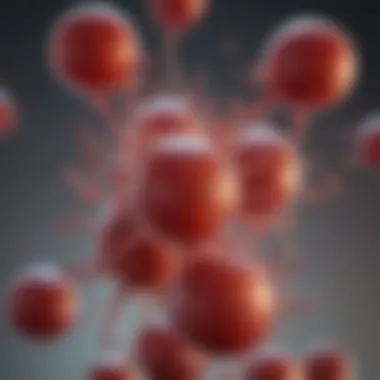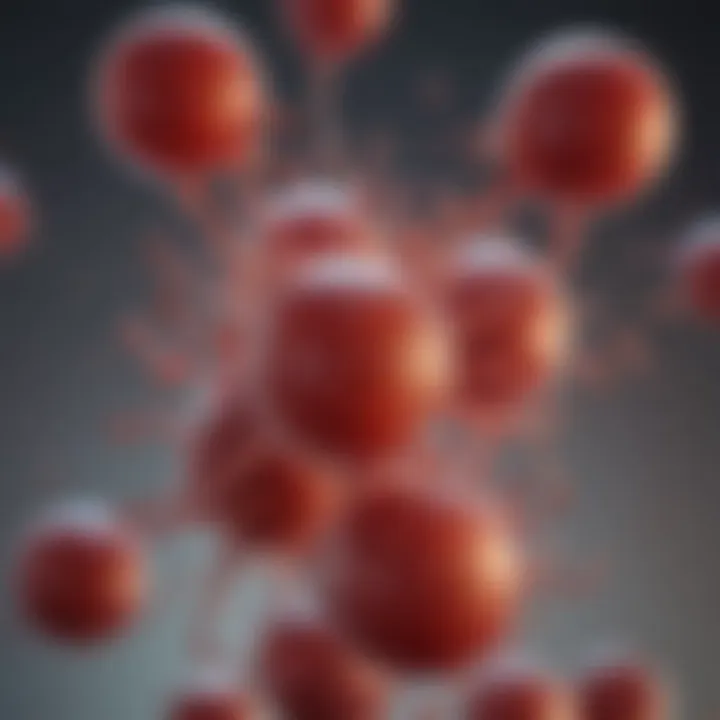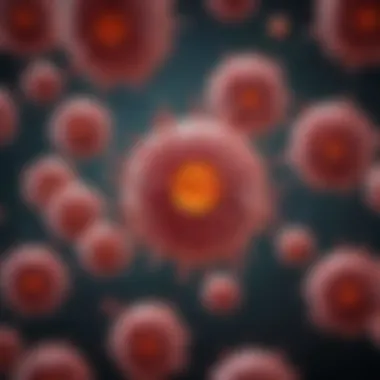Understanding CD4 Cells and Their Role in HIV


Intro
Understanding the role of CD4 cells is crucial in comprehending HIV pathogenesis. CD4 cells, also known as T-helper cells, are vital components of the human immune system. They facilitate communication between immune cells, helping to mount an effective response against pathogens. When HIV infects CD4 cells, it disrupts this essential function, leading to a cascade of immune system failures.
The implications of this disruption are significant. With a gradual decline in CD4 counts, individuals become increasingly susceptible to opportunistic infections and various other diseases. This has serious consequences, ultimately progressing to AIDS if not effectively managed.
As we explore the relationship between CD4 cells and HIV, the detailed analysis will encompass the biology of CD4 cells, mechanisms of HIV infection, and new therapeutic strategies currently under development.
Key Concepts and Terminology
Definition of Key Terms
- CD4 Cells: A type of T-cell that plays an essential role in immune system function, particularly in coordinating responses to infections.
- HIV: Human Immunodeficiency Virus, which targets CD4 cells, leading to their depletion and eventual immune system failure.
- AIDS: Acquired Immunodeficiency Syndrome, the most severe phase of HIV infection, characterized by a system so weakened that it cannot defend against opportunistic infections.
Concepts Explored in the Article
- The biology of CD4 cells and their role in the immune system.
- How HIV infects CD4 cells and the subsequent effects on the immune response.
- The significance of CD4 count monitoring in HIV patients.
- Innovative therapeutic strategies designed to combat HIV and restore CD4 cell counts.
Findings and Discussion
Main Findings
Research has consistently shown that the depletion of CD4 cells is central to the progression of HIV infection. Studies indicate that a decrease in CD4 counts correlates with an increased risk of opportunistic infections. Furthermore, strategies aimed at viral suppression, such as antiretroviral therapy, have been effective in preserving CD4 cell populations.
Overall, patients who maintain higher CD4 counts tend to have better health outcomes. Effective management of HIV requires understanding these dynamics and working towards minimizing CD4 depletion.
Potential Areas for Future Research
Future research may focus on:
- Enhancing CD4 cell recovery after patients begin antiretroviral therapy.
- Investigating novel therapeutic agents that boost CD4 cell production.
- Studying the long-term effects of low CD4 counts on patient health and quality of life.
Effective control of HIV replication is key to preserving CD4 cell numbers, which in turn safeguards immune function.
This framework lays the groundwork for further discussions surrounding the complexities of HIV pathogenesis and the indispensable role that CD4 cells play in this continuum.
Preamble to CD4 Cells
The role of CD4 cells is pivotal in the functioning of the human immune system. Understanding them is crucial for comprehending how HIV interacts with these cells. CD4 T cells are often referred to as the "helper" cells of the immune system. They assist other immune cells by releasing cytokines, which are signaling proteins that guide the immune response.
The importance of CD4 cells becomes especially pronounced in the context of HIV pathogenesis. HIV targets these cells specifically, compromising the immune system over time. This connection shows how critical CD4 cells are not only in fighting infections but also in maintaining the body's overall health. Recognizing their function and differentiating characteristics can provide insight into how HIV exploits this immune component to establish infection and lead towards AIDS.
Definition and Function
CD4 cells are a type of T cell characterized by the presence of the CD4 glycoprotein on their surface. Their primary function is to coordinate the immune response. They activate B cells that produce antibodies, stimulate cytotoxic T cells that kill infected cells, and help recruit other immune players like macrophages to sites of infection. This multifunctional approach makes them indispensable in mounting an effective immune defense.
In addition to their support role, CD4 cells play a significant part in memory immune responses. After an initial exposure to a pathogen, some CD4 cells differentiate into memory cells. These cells help the immune system respond more swiftly and effectively if the same pathogen invades again. Hence, their role is not merely reactive but also preventative, vital for long-term immunity.
Differentiation of CD4 Cells
The differentiation of CD4 cells is a complex process influenced by factors like cytokines and the nature of the pathogen. When naive T cells encounter an antigen, they begin to differentiate into various subsets of CD4 cells. Two of the most well-known subsets are T and T cells.
- T cells are primarily involved in activating macrophages and promoting cell-mediated responses. They are crucial in fighting intracellular pathogens like viruses.
- T cells, on the other hand, stimulate B cells and are essential for defense against extracellular parasites.


Other subsets, such as regulatory T cells (Tregs), help maintain immune homeostasis by preventing overactivity that could lead to autoimmune diseases. This dynamic differentiation process helps tailor the immune response to the specific type of threat, demonstrating the flexibility and adaptability of CD4 cells in immune function.
Overview of HIV
Understanding HIV is crucial for grasping the complex dynamics of CD4 cells in the pathogenesis of HIV. The virus poses significant challenges to the immune system, primarily targeting CD4 cells, which are essential for immune responses. In this section, we will cover vital aspects of HIV, including its structure and replication mechanisms, along with the epidemiology of HIV infection.
HIV Structure and Replication
HIV, or human immunodeficiency virus, is a retrovirus with a unique structure that facilitates its ability to infect host cells. The virus is composed of several key components:
- Env Protein: The envelope proteins, including gp120 and gp41, are critical for the virus to attach and enter CD4 cells.
- Core Proteins: These proteins form the viral core, which contains the viral RNA and enzymes necessary for replication.
- Lipid Bilayer: The viral envelope is derived from the host cell membrane, providing a means to blend in with host cells.
Upon entry into the body, HIV primarily targets CD4 cells, which play a vital role in orchestrating the immune response. The replication cycle begins when the virus attaches to the CD4 cell surface via the Env protein. Following this, the virus enters the cell through endocytosis. Once inside, HIV releases its RNA genome and reverse transcriptase enzyme. This enzyme converts viral RNA into DNA, which integrates into the host genome.
The integration allows the virus to replicate depending on the host cell's machinery, producing more viral particles and perpetuating the cycle of infection. Understanding this replication cycle helps inform treatment strategies targeting various points of the process, essential for managing HIV effectively.
Epidemiology of HIV Infection
HIV infection remains a significant global public health issue. It affects millions of people worldwide, and its epidemiology varies considerably across regions. Key points regarding the distribution and impact of the virus include:
- Global Statistics: Approximately 38 million people are currently living with HIV globally, with sub-Saharan Africa accounting for a substantial proportion of these cases.
- Transmission Modes: HIV can be transmitted through various means, including unprotected sexual contact, sharing needles, and from mother to child during childbirth or breastfeeding.
- High-Risk Populations: Certain populations, such as men who have sex with men, intravenous drug users, and sex workers, are at higher risk of HIV infection.
- Impact of Treatment Access: Access to antiretroviral therapy has been pivotal in reducing mortality rates and improving the quality of life for people living with HIV. However, stigma and lack of resources still pose barriers in many regions.
Understanding the structure, replication, and epidemiology of HIV is critical in designing effective interventions and therapies. Without addressing these fundamental aspects, the fight against HIV cannot progress adequately.
In summary, the overview of HIV emphasizes the importance of comprehending HIV's biology and its implications for public health. The effective targeting of HIV hinges on an understanding of its structure, replication cycles, and epidemiological patterns, directly impacting strategies to combat the disease.
Mechanism of CD4 Cell Infection by HIV
Understanding the mechanisms by which HIV infects CD4 cells is critical for comprehending HIV pathogenesis. HIV targets CD4 cells, which are essential for orchestrating immune responses. The impact of the virus on these cells is profound. The virus not only infiltrates but also utilizes the cellular machinery to replicate, leading to depletion and dysfunction of CD4 cells over the course of infection. Awareness of this mechanism can drive the development of improved therapeutic strategies.
Entry Pathways of HIV into CD4 Cells
HIV entry into CD4 cells involves a highly specific interaction between the virus and the host cell. The process starts when HIV binds to the CD4 receptor on the surface of the T helper cells. This binding is facilitated by the viral envelope protein gp120. Following this initial attachment, a conformational change occurs, allowing the virus to engage with a co-receptor, which is typically either CCR5 or CXCR4. This engagement is critical for viral entry.
After the co-receptor is bound, the viral membrane fuses with the host cell membrane. This fusion is mediated by another viral protein called gp41. Once the membranes merge, the viral core enters the CD4 cell's cytoplasm, allowing for subsequent stages of HIV infection.
The specificity of this entry process is significant because it highlights potential therapeutic targets. By blocking the interaction between HIV and CD4 or the co-receptors, new treatment modalities may halt the viral entry, offering a pathway to preserving CD4 cell populations.
Replication Cycle of HIV within CD4 Cells
Once HIV enters the CD4 cell, it hijacks the host's cellular machinery to replicate. The replication cycle of HIV consists of several distinct stages:
- Reverse Transcription: The viral RNA genome is reverse transcribed into DNA by the viral enzyme reverse transcriptase. This step is crucial as it converts the viral RNA into a form that can integrate into the host genome.
- Integration: The viral DNA is then transported into the nucleus, where it integrates into the host cell's DNA with the help of another viral enzyme known as integrase. This integration allows the virus to become a permanent part of the host cell's genetic material.
- Transcription and Translation: Once integrated, the host cell's machinery begins to transcribe the viral DNA into messenger RNA (mRNA), which is then translated into viral proteins.
- Assembly: New viral particles are assembled from these proteins and the newly synthesized viral RNA.
- Budding: Finally, the newly formed virus buds from the host cell, ready to infect additional CD4 cells.
This cycle results in high levels of viral replication, which contributes to the progressive loss of CD4 cells and, eventually, immune system failure. The understanding of the replication cycle can inform new therapeutic strategies aimed at disrupting specific stages, reducing viral load, and improving patient outcomes.
Key Insight: Understanding both the entry pathways and the replication cycle of HIV is essential for developing effective interventions to combat HIV infection and preserve CD4 cell function.
Impact of HIV on CD4 Cell Populations
The significance of understanding the impact of HIV on CD4 cell populations cannot be overstated. CD4 cells are essential for the immune system's response to pathogens. When HIV infects these cells, the consequences are dire, leading to immune deficiency. This section will explore two crucial aspects regarding this impact: the destruction of CD4 cells and the alteration of their function.
Destruction of CD4 Cells
HIV has a profound ability to destroy CD4 cells. The virus primarily targets these cells due to their role in the immune response, making them a key player in HIV pathogenesis. Once HIV enters a CD4 cell, it hijacks the cell's machinery for its replication. This process eventually leads to cell death, often through processes like apoptosis or direct viral-induced lysis.


The reduced number of CD4 cells leads to a weakened immune response. As the count of these cells declines, the body becomes susceptible to various infections and illnesses. Research shows that individuals with fewer than 200 CD4 cells per mm³ of blood are at a significantly higher risk of opportunistic infections. This vulnerability emphasizes the urgency of monitoring CD4 counts in HIV-positive individuals.
To put this into perspective, a healthy adult typically has between 500 and 1,600 CD4 cells per mm³. The stark contrast between a healthy count and a severely reduced count illustrates how effectively HIV can disable the immune system.
"HIV's ability to reduce CD4 cell counts outlines a direct pathway to AIDS development, diminishing the body’s defense system against infections."
Alteration of CD4 Cell Function
Beyond the destruction of CD4 cells, HIV also alters their function. When CD4 cells are infected, their ability to orchestrate an immune response is compromised. The virus can change how these cells communicate with other immune cells, disrupting the whole network that regulates the immune response.
Changes in functionality lead to an ineffective immune system. For example, infected CD4 cells might fail to activate B cells for antibody production or inhibit the activation of cytotoxic T cells. This dysfunction can prolong the duration of infections, making it difficult for the body to clear pathogens.
Moreover, the persistence of HIV within CD4 cells causes a state of chronic immune activation. In this state, despite the presence of the virus, the immune system continues to fight, which paradoxically results in immune exhaustion. This cycle leads to a further decline in CD4 cell numbers and function, a pivotal aspect of AIDS progression.
Understanding both the destruction of CD4 cells and their functional alteration is essential for developing effective HIV treatments. Moreover, securing healthy CD4 cell populations is vital for improved patient outcomes in HIV therapy.
Clinical Implications of CD4 Count in HIV Patients
The CD4 cell count plays a critical role in managing HIV patients. Monitoring this count is essential for assessing the immune system's strength. A healthier immune system can effectively respond to infections and diseases, which is crucial for people living with HIV. Thus, the CD4 count is not just a number; it has broad implications for treatment decisions, predicting disease progression, and assessing the overall well-being of the patient.
One of the significant clinical implications is that CD4 count serves as an indicator of immune function. A higher CD4 count usually suggests a more effective immune response, while a low count indicates potential vulnerability to opportunistic infections. Monitoring these values over time helps healthcare providers tailor treatment plans based on each patient's individual needs. This personalized approach can enhance the effectiveness of the devised strategies for managing their condition.
Moreover, the CD4 count provides insights into when to start treatment modalities such as antiretroviral therapy. By understanding these clinical factors, doctors can initiate medical interventions at appropriate stages in the progression of HIV infection. This early intervention can greatly improve patient outcomes and quality of life.
CD4 Count as a Marker of Immune Function
The CD4 cell count is a reliable marker of immune function in individuals with HIV. Regular assessments of this count help in identifying how well the immune system is functioning. In essence, when CD4 counts fall below critical thresholds, the risk for infections increases substantially.
Key points to understand include:
- Monitoring Frequency: Regular testing is recommended, usually every 3 to 6 months, to keep track of any changes in immune status.
- Health Risks: A CD4 count less than 200 cells/mm³ significantly raises the risk for opportunistic infections, indicating a clinically significant immunodeficiency.
Patients with higher CD4 counts typically respond better to antiretroviral drugs. This relationship underscores the importance of maintaining a robust immune function through appropriate treatment.
Thresholds for Treatment Initiation
Establishing thresholds for treatment initiation is a pivotal aspect of HIV care. Generally, a CD4 count below 350 cells/mm³ is often considered as a starting point for beginning antiretroviral therapy. However, the exact threshold can vary depending on individual patient circumstances and national or clinic-specific guidelines.
- 200 cells/mm³: This threshold serves as a crucial marker for initiating prophylactic treatment for opportunistic infections.
- 350 cells/mm³: This level is widely recognized for initiating antiretroviral therapy in asymptomatic patients.
Current guidelines, including those from the World Health Organization, advocate starting treatment irrespective of CD4 counts when it comes to promoting long-term health benefits and reducing transmission rates.
Keeping a close watch on CD4 counts is vital for successful HIV management. Providers must consider both clinical guidelines and the unique conditions of each patient for making informed decisions regarding treatment initiation. As research continues, these thresholds may evolve, potentially influencing future HIV treatment paradigms.
Current Treatment Strategies for HIV
Current treatment strategies for HIV have evolved significantly over the past few decades. The choice of treatment is crucial for managing HIV infection, preserving CD4 cell counts, and enhancing the quality of life for patients. It is essential to understand the available strategies to effectively combat the disease and improve outcomes.
Antiretroviral Therapy
Antiretroviral therapy (ART) remains the cornerstone of HIV treatment. This approach comprises a combination of medications that inhibit different stages of the HIV lifecycle. By using multiple classes of drugs, healthcare providers aim to suppress the viral load to undetectable levels. This not only minimizes the progression of HIV but also restores immune function by allowing CD4 cells to recover.
The key benefits of ART include:


- Viral Suppression: Lowering the viral load reduces the risk of transmission and helps maintain CD4 cell populations.
- Improved Lifespan: Patients on effective ART can live long and healthy lives with proper management.
- Quality of Life: Enhanced immune function can improve overall health and quality of life.
However, there are considerations to keep in mind. Adherence to the therapy is crucial, as missing doses can lead to drug resistance. Additionally, drug interactions and side effects should be monitored to ensure patient safety.
Novel Therapeutics and Research Directions
The landscape of HIV treatment is continually evolving, with ongoing research exploring novel therapeutics and approaches. These current research directions hold potential for improving patient outcomes and may pave the way for future advancements.
Some areas of active research include:
- Broadly Neutralizing Antibodies: These antibodies can target multiple strains of HIV and have shown promise in inhibiting virus entry and replication.
- Latency-Reversing Agents: These agents aim to flush out dormant HIV reservoirs, enhancing the effectiveness of ART by targeting hidden viral particles.
- Gene Editing Technologies: Techniques such as CRISPR are being investigated for their potential to edit the HIV genome, possibly leading to a functional cure.
"Understanding the developments in novel therapeutics is vital for the future of HIV treatment. The pursuit of innovative strategies could redefine how we approach HIV infections."
In summary, current treatment strategies for HIV focus on maximizing CD4 cell functionality and minimizing viral load through antiretroviral therapy and emerging therapeutics. Keeping abreast of these advancements is essential for students, researchers, educators, and professionals engaged in HIV research and treatment.
Future Directions in CD4 Cell and HIV Research
As the landscape of HIV research continues to evolve, understanding the future directions for CD4 cell and HIV research becomes crucial. CD4 cells, as pivotal components of the immune system, represent both a challenge and an opportunity in combating HIV infection. Therefore, the exploration of innovative strategies for vaccines, immune-based therapies, and long-term remission is essential for enhancing patient outcomes and addressing the ongoing challenges posed by HIV.
Vaccines and Immune-Based Therapies
The pursuit of effective vaccines against HIV has remained a paramount goal in HIV research. Unlike traditional vaccines that provide protective immunity, HIV vaccines aim to elicit a robust immune response against the various strains of HIV. Recent advancements have focused on mRNA technology, similar to that used in COVID-19 vaccines. These vaccines are designed to stimulate CD4 cells to recognize and combat the virus.
One significant strategy involves the use of broadly neutralizing antibodies (bNAbs). These antibodies can target diverse strains of HIV. Their usage may restore CD4 cell function or prevent the depletion of these crucial cells during the early stages of HIV infection. Immune-based therapies also seek to leverage the body’s immune response, prompting CD4 cells to mount a more effective defense against the virus.
The innovative approaches in vaccines and immune-based therapies offer a potential game changer in controlling HIV infection and enhancing immune resilience.
Long-Term Remission and Cure Strategies
Research surrounding long-term remission and potential cure strategies for HIV has gained momentum. Long-term remission refers to the sustained control of HIV replication without the need for continuous antiretroviral therapy. This concept hinges on the ability to maintain a sufficient CD4 cell count while preventing viral rebound.
One approach under investigation involves the use of gene editing technologies, such as CRISPR-Cas9, to modify the genome of immune cells. This could lead to CD4 cells that are resistant to HIV infection. Another promising avenue is the concept of viral reservoirs, which are sanctuaries where HIV can hide in the body. Eliminating these reservoirs may lead to a functional cure.
Additionally, therapeutic vaccination may enhance CD4 cell responses, aiming to control the virus without ongoing treatment. These strategies offer hope for moving beyond viral suppression toward a functional cure.
End
The future of CD4 cell and HIV research stands at the intersection of innovative treatment strategies and groundbreaking scientific advancement. Focusing on vaccines and immune-based therapies will not only improve the immune response against HIV but also aim for long-term remission or even a potential cure. As research continues, these areas will remain at the forefront, promising improved outcomes for individuals living with HIV.
Culmination
In summarizing the intricate relationship between CD4 cells and HIV, it is evident that understanding this dynamic is essential for advancing both research and treatment strategies. CD4 cells serve as pivotal components in the functioning of the immune system. Their role in HIV pathogenesis reveals not just the mechanisms of infection, but also the broader implications of immune system failure that leads to AIDS. A clear awareness of these interactions provides crucial insights for health professionals and researchers alike.
Summary of Key Findings
- CD4 Cells as Targets: HIV specifically targets CD4 cells, using them as a primary means to replicate and spread. This is detrimental to the immune response because it reduces the population of these vital cells over time.
- Destruction and Dysfunction: The virus not only destroys CD4 cells but also alters their functionality, resulting in an impaired immune system that struggles to respond to opportunistic infections and other pathogens.
- Clinical Relevance: A low CD4 count is a significant marker for clinicians, indicating the level of immunocompromised status in an individual and helping to inform treatment decisions.
- Emerging Therapies: Current advancements in antiretroviral therapies and ongoing research into vaccines and immune-based treatments reflect the continuous effort to manage HIV more effectively.
Implications for Future Research
The findings of this article point to several directions for future research that could further enhance the understanding of CD4 cells in HIV pathogenesis:
- Innovative Treatments: There is a need for continued exploration of novel therapeutics designed to restore CD4 cell counts and functionality in HIV-infected patients. Research on immune-based therapies also promises to bridge gaps in current treatment strategies.
- Vaccine Development: Future studies must prioritize vaccine research, aiming to provide long-lasting immunity or a means to prevent HIV infection by targeting CD4 cells directly.
- Long-Term Effects: More research is needed to understand the long-term effects of HIV on immune function. Understanding how the virus influences CD4 cells over time can lead to better management protocols.
- Microbiome Interactions: Investigating how the human microbiome interacts with CD4 cell dynamics in the context of HIV could reveal new aspects of immune modulation that may be exploited therapeutically.
Recommended Reading and Key Studies
Several key studies and literature can enhance the knowledge about CD4 cells and HIV. Here are some recommended readings:
- “HIV and the Immune System: How the Virus Attacks and Destroys CD4 T Cells” - This comprehensive paper details the mechanisms through which HIV infects CD4 cells, highlighting pathogenic processes.
- “The Role of CD4 T Cells in Antiviral Immunity” - A pivotal study that discusses the function of CD4 T cells in the context of viral infections beyond HIV, establishing their importance in the immune response.
- “Longitudinal Analysis of CD4 Cell Counts in Untreated HIV Infection” - This research tracks the decline in CD4 counts over time, which is critical for understanding how HIV affects immune health.
- “Novel Therapeutics Targeting CD4 Cell Restoration in HIV” - This recent publication provides insights into innovative treatment approaches aimed at restoring CD4 cell populations.
These references not only substantiate the information within this article but also inspire further exploration into the ongoing research that seeks to mitigate the effects of HIV on the immune system. Each piece illustrates the complexity and significance of CD4 cells in HIV pathogenesis, guiding future inquiries and clinical practices.







